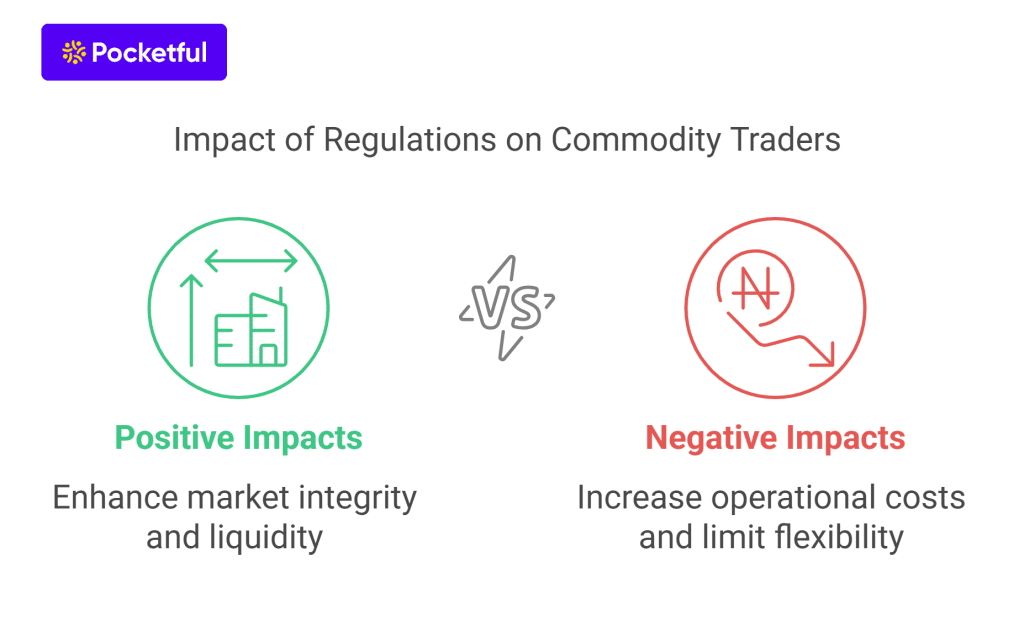| Type | Description | Contributor | Date |
|---|---|---|---|
| Post created | Pocketful Team | Jan-15-25 | |
| Infographic Update | Ranjeet Kumar | Apr-04-25 |
Commodity Trading Regulations in India: SEBI Guidelines & Impact

Commodity Trading is important for the global economy as it allows the trading of vital resources like crude, metals, and agricultural goods. But, there’s a catch – it’s not without risks as the market features volatile price shifts. The regulatory body has enforced strict rules to ensure safe and fair trading practices.
In this blog, we will examine commodity trading regulations and their impact on market participants.
What is Commodity Trading Regulation?
Commodity trading regulations refer to the framework of the laws and rules that govern the trading of physical goods and their associated derivative contracts. These commodities include agricultural products, energy resources, and metals. The commodity trading regulations safeguard participants from manipulation and insider trading by reducing excessive speculation that can cause extreme price volatility.
Regulatory Body in Commodity Trading
The Securities and Exchange Board of India (SEBI) regulates the commodity derivatives market in India. However, before September 28, 2015, the Forward Markets Commission (FMC) regulated the commodity futures market in India.
The FMC was merged with SEBI to improve regulation of the commodity futures market. SEBI now oversees commodity derivatives trading in India. Commodity exchanges that are regulated by SEBI are as follows,
- Multi Community Exchange of India (MCX)
- National Commodity and Derivatives Exchange (NCDEX)
Additionally, the Warehousing Development and Regulatory Authority (WDRA) collaborates with SEBI to oversee the storage of the physical commodities tied to derivative contracts.
Read Also: What is Commodity Market in India?
Regulations in Commodity Trading
Below are some of the key points from the SEBI guidelines for the commodity derivatives market.
Trading Hours
Trading hours are standardized for both agricultural and non-agricultural commodities. Trading shall be permitted only from Monday to Friday, and trading hours are fixed by the exchanges.
For non-agricultural commodities, the trade start time is 9:00 AM, and the trade end time is 11:30 PM (after the start of the US daylight savings in the spring season) and 11:55 PM (after the end of US daylight savings in the fall season). For agricultural and agri-processed commodities with international reference linkages, the trade start time is 9:00 AM, and the trade end time is 9:00 PM. The trade end time is 5:00 PM for agricultural and agri-processed commodities without international reference linkages.
Trading Holidays
The commodity market remains closed on weekends, i.e., Saturdays and Sundays and on all notified public and national holidays. However, there are a few public holidays on which the commodity market is open for trading for one session.
UCC & PAN
Unique client codes (UCC) are required for executing transactions on the exchange to ensure traceability and compliance with regulations, and brokers must disclose their proprietary trading to clients to improve transparency. Members of the exchange must upload UCC details before executing trades in the commodity derivatives segment. Furthermore, the PAN will be the only required identification number for anyone wishing to trade on a commodity derivatives exchange.
Warehouse Accreditation and Delivery Processes
Accredited warehouses are essential for the safe storage of the delivered commodities. Warehouse Service Providers (WSP) provide safe storage facilities for storing underlying goods related to a commodity derivatives contract. Standards regarding infrastructure, insurance, financial stability and corporate governance are set, and regular audits and inspections ensure compliance with quality and operational standards.
Transparency Measures and Disclosure Norms
Commodity exchanges should publicly report daily open interest, put call ratio, bhav copy and other market data to provide insights into market activities. Moreover, in the stock market, companies provide information related to commodity price risks and hedging strategies in their annual reports to help stakeholders evaluate their exposure.
Spot Price Polling
Commodity exchanges use Spot Price Polling Mechanism to determine current spot prices. Transparent spot price discovery is crucial for the smooth operation of the derivatives market, as these prices serve as reference points for contract settlements on the exchange. Commodity exchanges determine current spot prices by inviting price quotes from a panel of polling participants.
Support for Farmers and FPOs
SEBI has lowered regulatory fees on stock exchanges for agricultural commodity derivatives to encourage participation from farmers and Farmer-Producer Organizations (FPOs). The goal is to lessen the financial burdens on farmers by increasing savings from reduced regulatory fees by the exchanges. Farmers can get reimbursed a certain percentage or fixed amount of options premiums, which encourages them to participate in the derivatives market. Reimbursement of Mandi tax and clearing corporation fees are some other measures introduced to increase the participation of farmers and FPOs.
Investor Protection Mechanism
The IPF, or the investor protection fund, will be managed by a separate Trust, which will have a maximum of 5 trustees. The trust will include three public interest directors, one representative from the investor’s association, and the exchange’s chief compliance officer or chief regulatory officer. The objective behind establishing this fund is to protect investors by providing compensation to those who have been impacted by a defaulting trading member. IPF gets its money from penalties and regulatory fees.
Investor Grievance Redressal System
The stock exchange must create an Investor Grievance Redressal Committee (IGRC) to address investor complaints. Investors can submit their complaints through SCORES 2.0 (SEBI Complaint Redress System), which is a centralized grievance redressal system of SEBI. The complaint is first reviewed by the exchange and is then reviewed by SEBI.
Liquidity Enhancement Scheme (LES)
LES aims to boost trading in less active markets. The exchange’s board must approve the scheme after due diligence, review its effectiveness every six months, and provide SEBI with biannual reports. Exchanges must ensure the scheme is fair, transparent, and reviewed quarterly by their boards. Incentives like fee discounts or cash payments are designed to attract market makers. The scheme for a specific product lasts up to 3 years, aiming to boost liquidity without causing long-term dependence.
Impact of Regulations on Commodity Traders
Regulations and commodity trading greatly affect market participants. These impacts can be both beneficial (promoting stability and fairness) and challenging (creating constraints and operational burdens). Let us have a quick overview of the impact of regulations.

Positive Impacts
- Enhanced market integrity: Regulations ensure a transparent and fair marketplace by reducing fraud and unethical practices. Traders can feel more confident about the legitimacy of the trading environment due to the presence of strict regulations.
- Risk management: Regulations like margin requirements and position limits play an important role in reducing risk.
- Increased Liquidity and Participation: Strong regulatory oversight increases participation from institutional and retail investors, thus enhancing liquidity.
- Price transparency: Reporting and disclosure requirements improve price discovery, which helps traders and other market participants. Price information and other market data obtained from reliable sources such as the exchange website promote the development of competitive strategies.
- Investor Protection: Grievance redressal mechanisms protect small traders and investors.
Negative Impacts
- Operational Costs: Complex regulatory frameworks demand substantial resources and experienced professionals for reporting and audit purposes. Smaller trading members may find it difficult to compete because of the high cost of complying with strict regulations.
- Limited flexibility: Position limits, margin requirements, and contract specifications limit aggressive trading strategies. The restrictions may limit the profit potential for speculative traders.
- Increased oversight: Continuous oversight by regulatory bodies can lead to extra administrative work.
- Adapting To Dynamic Rules: Frequent regulatory updates require traders to stay informed and adaptable, which can be resource-intensive. Non-compliance, even if unintentional, can cause penalties or loss of trading rights.
Read Also: How to Trade in the Commodity Market?
Conclusion
SEBI’s regulations aim to establish a strong and transparent commodity trading system. SEBI promotes market stability and inclusivity, especially for farmers and small traders, by enforcing strict trading risk management systems and participant responsibility guidelines. These regulations protect investors and enhance India’s status as a growing hub for commodity trading. It is advised to consult a financial advisor before trading in commodities.
Frequently Asked Questions (FAQs)
Are there limits on how much a commodity’s price can move in a day?
SEBI imposes daily price limits or DPLs to prevent excessive volatility and speculative manipulation.
How does SEBI manage cybersecurity risk in trading?
Exchanges are required to carry out annual system audits, implement cyber security measures, and ensure real-time monitoring of trading platforms.
Why are regulations important in commodity trading?
Regulations ensure market transparency, prevent fraud, reduce volatility and protect investors.
What is the position limit in commodity trading?
Position limits restrict the maximum number of contracts a trader can hold to prevent market manipulation and speculative trading practices.
Can foreign investors participate in Indian commodity markets?
Foreign participants can trade in an Indian commodity market subject to SEBI regulations.
Disclaimer
The securities, funds, and strategies discussed in this blog are provided for informational purposes only. They do not represent endorsements or recommendations. Investors should conduct their own research and seek professional advice before making any investment decisions.